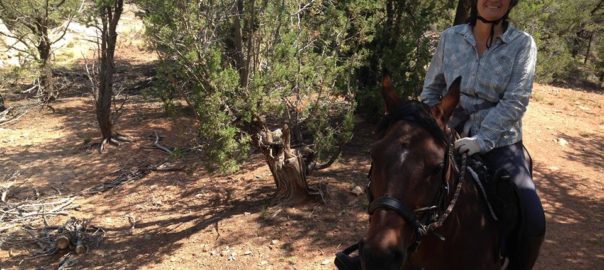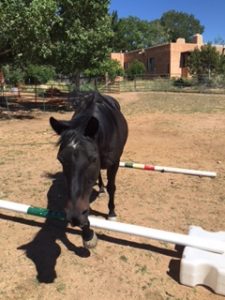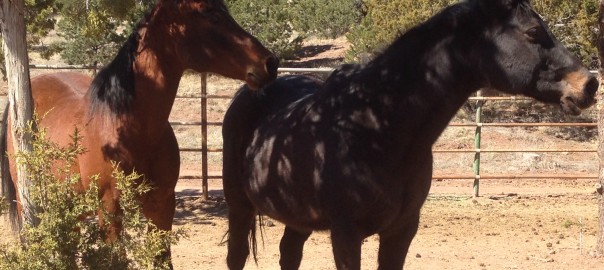We are all in this together, and yet we are to remain apart. There is stress about social distancing, our new norm, worldwide. Why is that? We can reach out and call people, thankfully we also have social media, but I still hear from friends, colleagues and clients that they feel isolated.

As a bodyworker for people and horses and the occasional dog, I feel it intensely. Ortho-Bionomy is a form of bodywork that is not just a spa treatment that you receive when you get a gift certificate and you feel better for a couple of days and forget about it. Ortho-Bionomy is transformative, it deepens your own body’s understanding of itself, it reaches inward and brings health and balance to all your systems. Each level of the body – bone, muscle, sinew – each system – circulatory, lymph, visceral – is affected by an Ortho-Bionomy session. It invites the body to come meet itself and have a conversation. And that conversation can continue on long after the session is over, well into the next week or months, depending upon your body’s ability to correct itself and stay corrected.
 The possibility of a “conversation with a body” was the hook for me when I was first finding out about bodywork modalities. What is that like? Is that possible? I wondered. Years later, I realize my body seeks that. If I cannot afford the time or money to get a session, then I feel the need. I gravitate towards self-care, and other exercises of course. They are immensely helpful.
The possibility of a “conversation with a body” was the hook for me when I was first finding out about bodywork modalities. What is that like? Is that possible? I wondered. Years later, I realize my body seeks that. If I cannot afford the time or money to get a session, then I feel the need. I gravitate towards self-care, and other exercises of course. They are immensely helpful.
I will talk about the importance of touch. What I learned recently is that the skin and brain are developed from the exact same primitive cells. So you could say the skin is the outer surface of the brain, or view the brain as the deepest layer of the skin. When you think of it this way, it is no wonder that we are troubled by the lack of human physical contact. There is much more about this but this is food for thought. With animals we have the fur factor – fur closely attached to skin.

According to the anatomy book, Job’s Body, by Deane Juhan, studies done by Johns Hopkins Hospital in 1915 in orphanages revealed the infant mortality rate within one year of admission was 99%. This led to further studies of all orphanages, finding that they were severely understaffed and consequently the infants lacked human cuddling. There was only enough time, to clean, feed and take care of their basic needs. Once more staff were added in a major overhaul of the system, the children received much needed cuddling, and they thrived in all ways. Great increases in energy, height, weight and mental well-being were seen – and the death rate decreased exponentially.
So when we must deprive ourselves, even as adults, of this very primal need for touch communication, where do we go next? When we’re advised to curtail all “non-essential” activities, I and my clients don’t consider Ortho-Bionomy non-essential. But since it is not an essential such as going to the grocery store (far more dangerous!), we comply with the rules that are intended to save our lives.
As a bodyworker, working on any body is never a one-way conversation. I’m not just doing techniques to or on someone. I’m asking questions, the body or being is speaking back to me in numerous ways. It’s not always something I can verbalize.
Today we are dealing with a deadly virus that is shaping the social structure of our lives. We must not touch, except those in your own household, period. Stay a safe distance away.
Fortunately, Ortho-Bionomy has a number of “phases,” unlike some modalities where the only option is touch. I can take the conversation off the body and have that conversation a little farther away, over the phone maybe, or in space, because the conversation has an energetic quality. I know some people are scared off by the mention of “energy,” but we are all energy, everything possesses energy. So it really isn’t frightening. It might seem frightening to imagine someone tinkering around with your energy.
But that’s not what I’m talking about. It’s the energy of the conversation that can remain alive without the physical touch, without any force or intrusion into the person or animal’s consciousness. I can work with the body without the body being anywhere nearby. It’s a part of Ortho-Bionomy and it is only done with consent of the individual.
There is a collective consciousness right now that has everyone on edge, trying to find balance but getting knocked off balance daily, in some cases hourly, by some new grisly news report. Is that collective consciousness something you can see or is it something you feel? Think about it. It’s all energetic, rippling through the global community.
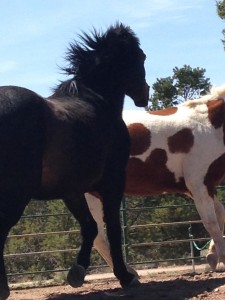 Horses have a herd mentality. Part of that is communicating without touching – flattening their ears or moving toward another horse across the pasture to get them to move, just twitching an ear in some cases. I only wish I had ears that talented. They also communicate with other species like birds. They can keep each other healthy and safe by moving the least among them. Their finely tuned energetic sense of what they need to have happen means everything.
Horses have a herd mentality. Part of that is communicating without touching – flattening their ears or moving toward another horse across the pasture to get them to move, just twitching an ear in some cases. I only wish I had ears that talented. They also communicate with other species like birds. They can keep each other healthy and safe by moving the least among them. Their finely tuned energetic sense of what they need to have happen means everything.
Before the pandemic took such a tight hold of us, (just a couple of weeks ago, perhaps?) I did an Energetic Healing Communication session with a dog who was limping. She had been expecting the session. The owner asked that I take her own injured finger into consideration too if I had time. I worked with the areas the owner had said she felt the dog needed work. I felt the session was very concrete, meaning very mechanical for her, but that was what she was asking for. She even became impatient with me at times.
Then she said: “guarding causes you to lock out, then fear, then lose the ability to take in good things.”
This was very huge, not only for the dog but for the owner, and for me. We are all guarded right now. We have to be but we will be wise to remember what that does to our nervous system. It makes us less able to notice or receive good things.
And then, the dog wove her owner’s physical injury into her own healing. I worked with the area between the nails of the paws. The owner reported her finger feeling 75% better. The dog ended her session on her own, satisfied, and went to lie down and rest.
That will probably never happen again in exactly that way or even close to it. That is the beauty of Ortho-Bionomy bodywork. It is special, it is for you personally, or for you and your dog or horse or cat and it is tailored to your needs. It is not a panacea, a pill or a blanket solution.
So, while this may sound farfetched to some and right at home to others, I will leave you with this: we need communication. We need the conversation, and if it isn’t physical, then energetic. We communicate in some different ways than horses or dogs. We have the higher intellect, or so I’m told.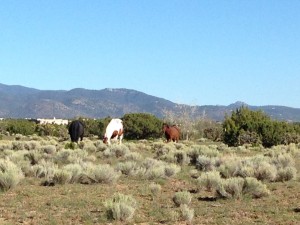
Yet, we aren’t as good at taking care of ourselves energetically as animals are. We have to be conscious of making sure to keep ourselves open to good things, like the wise dog said, while we are in these oppressive times.
So reach out and don’t touch someone, but do – energetically – across time and hold space for them and their healing. In that small way, I hope we can make a significant difference.
P.S. You may touch your horse, dog or cat!







 All of us – horse and human – hold tension in our bodies and we also have areas that just don’t speak. We have places that don’t work as well as others. My right leg can get funky in the hip socket, for example. I could sit up there and worry about what a terrible rider I am and I shouldn’t ride because I’m not always symmetrical and blah blah blah, but if I focus on all the dysfunction, then I am missing what my body can do, and how it can support the areas that aren’t working quite so well. My horse has stuff going on in her hips also. I focus on the healing available in her body. And guess what? Even though she has that stuff, she is a beautiful mover. I sit on her, and I feel each part of me and her, and focus on the parts that work really well while holding an awareness of what I’d like to have shift.
All of us – horse and human – hold tension in our bodies and we also have areas that just don’t speak. We have places that don’t work as well as others. My right leg can get funky in the hip socket, for example. I could sit up there and worry about what a terrible rider I am and I shouldn’t ride because I’m not always symmetrical and blah blah blah, but if I focus on all the dysfunction, then I am missing what my body can do, and how it can support the areas that aren’t working quite so well. My horse has stuff going on in her hips also. I focus on the healing available in her body. And guess what? Even though she has that stuff, she is a beautiful mover. I sit on her, and I feel each part of me and her, and focus on the parts that work really well while holding an awareness of what I’d like to have shift. With Ortho-Bionomy© for both horse and rider, we can learn what is holding up the bus. Riding instructors have wonderful ways of encouraging the horse forward, ways for riders’ to hold their legs so that the legs are not being counterproductive for the horse, or to sit correctly so as not to impede the horse’s movement – all of that has to do with the anatomy and the relationship of the two bodies working in sync, or not.
With Ortho-Bionomy© for both horse and rider, we can learn what is holding up the bus. Riding instructors have wonderful ways of encouraging the horse forward, ways for riders’ to hold their legs so that the legs are not being counterproductive for the horse, or to sit correctly so as not to impede the horse’s movement – all of that has to do with the anatomy and the relationship of the two bodies working in sync, or not.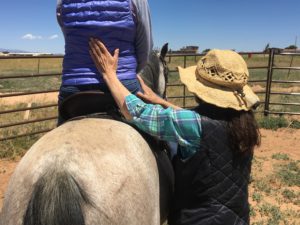
 Certainly, work can be done on some of these issues independently of the horse/rider relationship, and I do that in many cases where a person may need individual table work ahead of a horse/rider session, or the horse needs to receive an entire session on his own. If someone has major back trouble, I’m going to work on that, and same with the horse. But once the bodies are free of great inhibition, we can bring them together and see where they can strengthen and enhance each other, and bring space into the relationship that may have been restricted before.
Certainly, work can be done on some of these issues independently of the horse/rider relationship, and I do that in many cases where a person may need individual table work ahead of a horse/rider session, or the horse needs to receive an entire session on his own. If someone has major back trouble, I’m going to work on that, and same with the horse. But once the bodies are free of great inhibition, we can bring them together and see where they can strengthen and enhance each other, and bring space into the relationship that may have been restricted before. ways of beginning this work. While grooming your horse you can feel along the spine for any irregularities. If you don’t know anatomy, it’s helpful to get a simple equine anatomy book – and a human one while you’re at it! Learn where the bones are. Everything else is related to or attached to the bones in some way, so it’s a great place to start.
ways of beginning this work. While grooming your horse you can feel along the spine for any irregularities. If you don’t know anatomy, it’s helpful to get a simple equine anatomy book – and a human one while you’re at it! Learn where the bones are. Everything else is related to or attached to the bones in some way, so it’s a great place to start.

 After that I may do a little bit of bodywork on areas I see are not working so well on my horse, and stretch out myself. You can apply your own exercises, such as qi gong, yoga, Feldenkrais, etc. and in Ortho-Bionomy© we have a lot of self-care exercises for people and ones you can do for your horse. Some of them I have adapted to use in the saddle as well.
After that I may do a little bit of bodywork on areas I see are not working so well on my horse, and stretch out myself. You can apply your own exercises, such as qi gong, yoga, Feldenkrais, etc. and in Ortho-Bionomy© we have a lot of self-care exercises for people and ones you can do for your horse. Some of them I have adapted to use in the saddle as well. Much thought has been given over centuries to how to ride efficiently and so as to bring out the best in the horse and rider. With the Mounted Body Balance™ approach, an older horse can move better than he or she ever has and so can her rider. Life isn’t static so we can’t guarantee that any of us are not going to have some physical challenges, but there is a lot we can solve and make more comfortable with this type of work. A horse may be able to help you with your body issues without impairing his/her own stride or balance. Of course, aging will limit what you can do but why not try to do what you love comfortably for as long as you can? As a physical therapist friend of mine says, “I’m here to help you be able to do what you love for longer.”
Much thought has been given over centuries to how to ride efficiently and so as to bring out the best in the horse and rider. With the Mounted Body Balance™ approach, an older horse can move better than he or she ever has and so can her rider. Life isn’t static so we can’t guarantee that any of us are not going to have some physical challenges, but there is a lot we can solve and make more comfortable with this type of work. A horse may be able to help you with your body issues without impairing his/her own stride or balance. Of course, aging will limit what you can do but why not try to do what you love comfortably for as long as you can? As a physical therapist friend of mine says, “I’m here to help you be able to do what you love for longer.”













